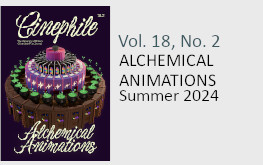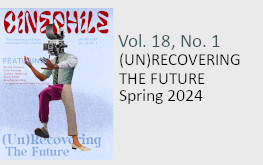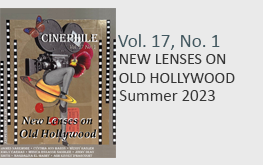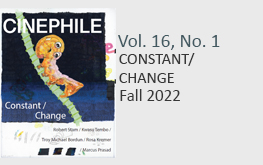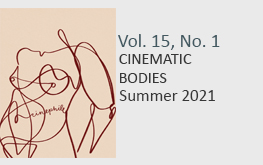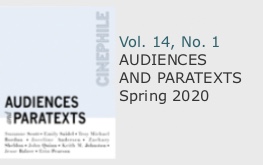Andrew Nelson
And now, a carriage approaches to carry you into the boundless realm of the supernatural. Take your loved ones by the hand, please, and kindly watch your step. Oh yes, and no flash pictures, please! We spirits are frightfully sensitive to bright lights.
– The Ghost Host of the Haunted Mansion ride
This essay has two interrelated aims: one, to analyze a group of commercial movies that have a unique pedigree, and two, to argue for the enduring relevance of genre in the analysis of motion pictures. I do not contend, however, that the movies in question constitute a genre, so am therefore not arguing for the relevance of genre on the grounds of its ability to organize or categorize movies into useful groupings. Rather, through an examination of these movies in their historical context as products of the Walt Disney Studio and Company, I arrive at the idea that genre criticism is a more productive way of understanding them than (what might seem to be) a more obvious alternative.
Perhaps the most influential theoretical concept to come out of the study of early cinema is the cinema of attractions. Borrowing the term attraction from Sergei Eisenstein, Tom Gunning first proposed the concept in detail in “The Cinema of Attractions: Early Film, Its Spectator and the Avant-Garde.” The cinema of attractions recasts pre-classical or primitive cinema as a mode unto itself, distinguished from later cinema’s emphasis on storytelling by an active solicitation of a viewer’s interest by means of overt display. Writes Gunning: “[T]his is a cinema that displays its visibility, willing to rupture a self-enclosed fictional world for a chance to solicit the attention of the spectator” (57). As Charlie Keil has noted, Gunning’s substitution of the term ‘cinema of attractions’ for ‘primitive cinema’ was a highly influential intervention in the analysis of the opposed features of the primitive and the classical (2001: 8). And yet the attraction of the attractions model has extended far beyond the boundaries of early cinema.
Gunning dates the end of the dominance of the cinema of attractions to around 1906-1907, but he maintains that attractions do not simply vanish with the cinema’s subsequent transition towards telling stories, a period he elsewhere terms the ‘cinema of narrative integration.’1 Instead, attractions go ‘underground.’ In the subsequent article “An Aesthetic of Astonishment,” Gunning writes:
[E]ven with the introduction of editing and more complex narratives, the aesthetic of attractions can still be sensed in periodic doses of non-narrative spectacle given to audiences (musicals and slapstick comedy provide clear examples). The cinema of attractions persists in later cinema, even if it rarely dominates the form of a feature film as a whole. It provides an underground current flowing beneath narrative logic and diegetic realism…. (38)
Just as the area of early cinema has been appealing to certain specializations within the field of film study as a period of possibility – prior to the institutionalization of classicism – the notion that attractions persist almost subversively into the classical era (and beyond) has made the theory similarly appealing. Linda Williams, for example, has praised the concept of attractions because “in addition to being [an] apt description of early cinema it describes all aspects of cinema that have also been undervalued in the classical paradigm” (1995: 12). Indeed, questions about the nature of cinematic attractions (particularly as they attend to affect and sensation) inform, at least in part, recent debates about the role of modernity in the development of the medium.
A related project has sought to reclassify Hollywood classicism as delineated in David Bordwell, Kristin Thompson and Janet Staiger’s influential study The Classical Hollywood Cinema: Film Style and Mode of Production to 1960 in order to figure in a larger role for the influence of modernity. Miriam Hansen, in “The Mass Production of the Senses,” argues that conceiving of Hollywood cinema of the studio era in terms of a ‘vernacular’ modernism will help restore historical specificity to the concept of classical Hollywood cinema. She writes:
The reflexive dimension of Hollywood films in relation to modernity may take cognitive, discursive and narrativized forms, but it is crucially anchored in sensory experience and sensational affect – in processes of mimetic identification that are more often than not partial and excessive in relation to narrative comprehension (343).
Although she does not invoke the model explicitly, Hansen’s de-emphasis of narrative and conceptualization of vernacular modernism as reliant on “sensory experience and sensational affect” is clearly related to the cinema of attractions.
Finally, the attractions concept has also been adopted as a model of spectatorship suitable for describing the postmodern moviegoing experience. While this move is not, as we shall see, necessarily dependent on an altered understanding of Hollywood classicism, it is nonetheless a connected development. Keil has observed how the dislodging of classicism would allow for the construction of a more direct lineage between modernity and postmodernity. He writes: “To do so would prove one of the central tenets of the modernity thesis: that modernity’s influence continues unabated until the arrival of the postmodern moment” (2004: 61).
One need not invoke the cinema of attractions to arrive at the idea that contemporary cinema is more concerned with soliciting audience attention through spectacle than with telling stories (or, more specifically, that beginning with the court-mandated industry divestiture in the 1940s there has been an increasing shift away from narrative and towards attractions). Warren Buckland has summarized a standard characterization of the post-classical, postmodern Hollywood movie as follows:
Many critics argue that, in comparison with Old Hollywood, New Hollywood films are not structured in terms of psychologically motivated cause-and-effect narrative logic, but in terms of loosely-linked, self-sustaining action sequences often built around spectacular stunts, stars and special effects. Complex character traits and character development, they argue, have been replaced by one-dimensional stereotypes, and plot-lines are now devised almost solely to link one action sequence to the next. Narrative complexity is sacrificed on the altar of spectacle. Narration is geared solely to the effective presentation of expensive effects (167).
While Buckland, as evidenced by the tone of his writing, is skeptical of these claims, it cannot be denied that the position he outlines is a common one. It would seem that, regardless of where they went or how strongly they persisted throughout the classical era, attractions are back, and in a big way.2
One scholar who has directly related contemporary Hollywood film with the cinema of attractions is Linda Williams, in a short but suggestive section of her essay “Discipline and Fun: Psycho and Postmodern Cinema” titled “The New ‘Cinema of Attractions.'” Williams begins by remarking how some scholars of early cinema have noted that the “sensational pleasures” of early cinema have affinities with the contemporary return to “sensation in special effects, extreme violence and sexual display” (356). It is this current emphasis on cinema’s dual ability to show new or sensational sights and to attract viewers to this display that recalls the cinema of attractions. Yet despite pointing to the similarity between contemporary Hollywood fare and the cinema of attractions, Williams takes care to note that these are not the same attractions as those posited by Gunning. As her section heading indicates, this is a ‘new’ cinema of attractions. In line with Hansen’s comment that sensory reflexivity exceeds narrative, Williams states that “while narrative is not abandoned in ever more sensationalized cinema, it often takes second seat to a succession of visual and auditory ‘attractions'” (356).
This subordination of narrative to cinema’s more visceral pleasures – Buckland’s aforementioned “stunts, stars and special effects” – leads Williams to comment on the parallels between contemporary cinema and the literal attractions of fairground rides. Noting how it was the amusement park rollercoaster that Eisenstein had in mind when he coined the term attractions, Williams locates a rollercoaster-like quality in the blockbuster films that characterize the New Hollywood: “[M]any films now set out, as first order of business, to simulate the bodily thrills and visceral pleasures of attractions that not only beckon to us but take us on a continuous ride punctuated by shocks and moments of speed-up and slow-down” (357). She goes on to note how, at the same time, some contemporary hit movies have been adapted into rides at Universal Studios’ theme parks. So, in Williams’ assessment, traditional rollercoasters have become more like the movies, and movies have become more like rollercoasters. She writes:
In this convergence of pleasures the contemporary, postmodern cinema has reconnected in important ways with the ‘attractions’ of amusement parks. But these attractions themselves have been thematized and narrativized through their connection with the entire history of the movies (358).
While the likeness between today’s blockbusters and theme park rides is not a new observation, Williams’ decidedly upbeat take on these new attractions within mainstream cinema, with their sensorial shocks and affective pleasures, stands in contrast to other reactions, which are often characteristically negative. As much as a film being called a ‘thrill ride’ is a good thing, the apparent (and apparently increasing) reliance by contemporary Hollywood on elements like special effects sequences is often lamented – although not, it must be added, to a large enough degree that such films are no longer made, or audiences choose not to patronize them.
In the short time since Williams penned her essay there has been a subsequent development at the intersection between movies and rides – a development that has the potential to extend the cinema of attractions model in a new and interesting way. The Walt Disney Studio has in recent years adapted several of the company’s well-known Disneyland theme park rides into feature films. To date, six such movies have been released: beginning in 2002 with The Country Bears, based on the now-defunct Country Bear Jamboree, followed in 2003 by The Haunted Mansion, from the ride of the same name, and, most famously, a trilogy of films based on The Pirates of the Caribbean ride (released in 2003, 2006 and 2007). In addition, projects based on the Jungle Cruise and Space Mountain rides are reportedly in development. Not unlike the numerous adaptations, remakes and sequels released today, these Disney films could be seen as even more evidence that Hollywood has, indeed, run out of new ideas. And to those among us who regard much of contemporary cinema as mindless spectacle, these movies could represent the inevitable evolution of the recent trend described by Williams, where ‘ride the movies’ has lead to ‘movie the ride.’ This is not a cinema of attractions; this is a cinema from attractions.
Developing feature films from theme park rides is certainly related to the general practice at Disneyland and other movie-based parks of creating rides based on popular movies or developing them in conjunction with upcoming releases. Furthermore, the practice of adapting existing, well-known ‘properties’ into motion pictures has been around since the advent of the medium – even if, as noted above, the practice may seem more widespread nowadays. In fact, internet scuttlebutt holds that then-Disney studio head Jeffrey Katzenberg first began exploring the possibility of creating films based on some of Disneyland’s best known rides in the early 1990s. But that it was over a decade before such projects came to fruition indicates the challenge involved in bringing a theme park ride to the big screen.
Since Williams asserts that rides are increasingly cinematic in nature, perhaps her claim requires more careful scrutiny. How, exactly, have rides borrowed from the movies? Writes Williams:
Either they simulate a diegetic world through cinematic mise en scène…or they are elaborate updates of early cinema’s Hales Tours, ‘moving’ the audience through virtual, electronically generated space…[where] the narrative information that we are out of control enhances the virtual sensation of wild careening (358).
Williams posits that movies and rides have reached a point of convergence where the distinction between the two becomes blurred. As such, we return to the notion of narrative as secondary to attractions: theme park rides draw upon cinematic devices in order to enhance the experience of sensation. Not all rides are like this, however, and we should question whether this position risks overlooking the diversity of rides offered by a movie-based theme park. Many rides at Disneyland offer little in the way of cinematic mise en scène or narrative; indeed, some of the park’s most popular attractions, like the Big Thunder Mountain Railroad rollercoaster or the spinning tea cups of the Mad Tea Party, are more like the rides one might find at a traditional fairground.3
Williams’ claim that certain rides aim to “simulate a diegetic world” is fundamentally true, but understates the degree to which rides like The Haunted Mansion, Pirates of the Caribbean, The Country Bear Jamboree (and even Disneyland in general) are designed to immerse the visitor in the story world of the attraction. This is not simply a matter of semantics or differing emphasis. More than just being ‘cinematic’ (because some are not), these attractions create fantasy worlds of which park patrons are made a part. Put another way, there is a difference between an amusement park and a theme park, where the attraction is not so much the sights, sounds and shocks, but something much larger: being made a part of the thematically-unified story world, with an unfolding line of action. This is not to say that these rides have cause-and-effect narratives in the same way that films do, but rather that the matter of story plays a far greater role in these attractions than has been previously allowed. And this need not occur in the form of a thrill ride.
The Country Bear Jamboree was not a ride but a concert featuring audio-animatronic singing bears. Park visitors would gather outside the closed doors of Country Bear Hall in Frontierland. Inside, as the (human) attendant would inform the waiting patrons, the Bears were “finishing their sound check.” The surrounding walls were adorned with Country Bear memorabilia: magazine covers, platinum records, concert posters. A schedule for the band’s upcoming world tour was also posted. Finally, the doors would open, the guests would take their seats in the hall, and the concert would begin. In this way, the Country Bears have a past, present and future. The attractions – in this case, singing bears – are given a kind of narrative, which formed the background for The Country Bears movie: the band has broken up, Country Bear Hall is about to be demolished, and only a reunion concert of epic proportions can save the day (from the evil Christopher Walken).
Unlike The Country Bear Jamboree, Pirates of the Caribbean and The Haunted Mansion do not feature fleshed-out characters (literally so in the case of the latter). Each is a mechanized ‘dark ride’ that transports visitors through an immersive, simulated environment: the pirate-infested Caribbean on the one hand, and a haunted New Orleans mansion on the other. In the case of adapting these rides into feature films, a useful parallel can be drawn with comic book adaptations, which must negotiate between remaining faithful to an established iconography and mythology – but not to the point of alienating or turning off those unfamiliar with said elements – while fashioning a new narrative. This seems to be the crux of the matter, as it is not enough simply to pack a film with references to the source material.
The Haunted Mansion, in particular, incorporates many of the theme park ride’s best-known aspects into the movie’s story. Iconic elements like the hangman from the tower, the bride with the beating heart, the ballroom dance and the disembodied gypsy Madame Leota each play a central, causal role in the film’s narrative progression; in this way, elements from the ride are highly suggestive in the development of the filmic adaptation.4 With that said, there still remain moments in the film where features from the ride appear but do not serve to propel the movie’s story forward. A noteworthy example is a brief, transitional scene that has the main characters riding in a horse-drawn hearse through the Mansion’s ghost-infested cemetery. In terms of inclusion of particular phantoms, the scene is a near-replica of a corresponding portion of the ride. Two of the ride’s best-known elements – the “Grim Grinning Ghosts” singing busts and the three hitchhiking ghosts – are spotlighted, albeit in what could be called non-narrative ways as extended bits of comedy. Are these the visual and auditory attractions suggested by Williams? Or even, perhaps, the periodic doses of non-narrative spectacle of Gunning’s underground attractions? While both descriptions may seem appropriate, under an expanded consideration of their theme park heredity these ‘attractions’ take on another, transtextual dimension.
On the premier episode of the Disneyland television program, broadcast October 27, 1954 on ABC, Walt Disney told his viewers they would find that “Disneyland the place and Disneyland the TV show are all part of the same.” In actual fact, Disney was initially hesitant to expand his animation business into television, fearing that the quality of his productions would suffer due to the quantity of programming demanded by a regularly scheduled television show. At the same time, the Disneyland theme park would not build itself, and increased revenue was required to finance the project. Disneyland, the television show, was the answer. The program’s anthology format, as hosted by Disney himself, helped to address the problem of supplying a large enough quantity of high quality programming. Rather than producing a single continuing series, the content would vary from week to week, including both new material and cartoons from Disney’s existing catalogue. This also tied the show to the very make-up of the to-be-completed theme park, as each week’s broadcast would correspond to one of the lands that were to make up Disneyland: Frontierland, Tomorrowland, Adventureland and Fantasyland. In this way, the show promoted the park, and the park promoted the show. And, importantly, both made money.
The Walt Disney Company has a long history of using creative properties to link together its various business concerns. This is the famous Disney synergy. What is the point of making movies based on rides, or rides based on movies for that matter, if there is not money to be made? As crass as such an assessment may sound, the financial imperative behind these ventures must not be overlooked. As Jeff Smith has pointed out, synergy spreads financial risks. He writes: “By creating multiple profit centers for a single property, synergy spreads risk among several different commodities” (188). Disney’s theme park movies promote their rides and the rides promote the movies. Yet the rides also predate the films by many decades, making this instance somewhat different than having a novelization, a line of action figures, a soundtrack and a breakfast cereal available to coincide with a movie’s release.5 It also raises questions about the degree to which the inclusion of seemingly non-narrative moments like those described above in The Haunted Mansion are, in fact, relying upon our recognizing devices from our past experiences – a chief component of how genres are understood to function.
A fairly commonplace idea about movie genres is that they involve the interplay of repetition and difference, or convention and innovation. An individual film draws on a pre-existing tradition of representations – including iconography, character types and story elements – and fashions them into a new-yet-familiar narrative. In this way, genres rely on a process by which viewers understand the appearance of certain elements in a movie as motivated on transtextual grounds. While the contention is not, again, that these films are themselves – individually or aggregately – a genre, whether they function like genres is certainly a fair question. Are these films, for example, drawing on representational traditions that, like genres, have established conventions? Consider: Pirates of the Caribbean and The Haunted Mansion opened in Disneyland 1967 and 1969 respectively. Both also opened at The Magic Kingdom in Walt Disney World (Florida) in 1971 and 1973. Also, versions of both rides exist at Disneyland Paris and Tokyo Disney,6 and installments of each are planned for the newly-opened Hong Kong Disneyland. The Country Bear Jamboree, the youngest of the three Disneyland attractions, ran for twenty-nine years before its closure in 2001, and identical versions are still in operation at Walt Disney World and Tokyo Disney. With an estimated 13 million people now visiting Disneyland annually,7 and given that these rides have been in operation (and promoted across the company’s various media platforms) for well over thirty years, the likelihood that a moviegoer is familiar with either ride is quite high.
With this in mind, moments like those from The Haunted Mansion’s graveyard sequence are less “non-narrative attractions” than moments of transtextuality. In general, then, the attractions model risks misrepresenting not only the role of narrative but also understating not only the degree to which moments of seemingly non-narrative material are motivated transtextually, but also the degree to which moviegoers are aware of these operations. When Gunning first proposed the cinema of attractions his model had a high degree of specificity; while it was posited as the ‘dominant’ mode of cinema, it did not preclude the possibility of other forms of cinematic representation. Today, however, the term ‘cinema of attractions’ is largely synonymous with all pre-narrative film. But this extension of the attractions model has the unfortunate side effect of downplaying the diversity of not only early cinema but also the cinema that follows. Likewise, conceiving of contemporary Hollywood moviemaking as dependent on the plotless succession of effects-driven action sequences exaggerates the degree to which movies today are made in the ‘blockbuster’ mode. In actuality, a film company relies on a few big hits to finance the remainder of its production slate, which is largely made up of smaller films. Moreover, as Kristin Thompson has noted, many of the most successful blockbusters, like Jurassic Park (1993) or Titanic (1997), tend to be those that are the most classical in their storytelling. As further evidence against Williams’ position that we now go to the movies “to be thrilled and moved in quite visceral ways, and without much concern for coherent characters or motives” (356), we can note how the prevailing criticisms of contemporary cinema have very much to do with narrative concerns: unbelievable characters, unmotivated actions and events, formulaic plots, and so on. That Disney would look to develop a feature film based on Space Mountain rather than Big Thunder Mountain Railroad, despite both being rollercoasters, should not surprise us; only the former, like the rides already adapted into features, creates for its patrons a self-enclosed fictional world – a futuristic spaceport, where the ‘experience’ begins long before they ‘blast off’ and continues after they have returned safely from their journey.
The importance of story is apparent both in the Disney Company’s selection of which rides it adapts into feature films and in the effort to further deploy an attraction’s featured elements into a coherent, causal narrative. Moreover, in those moments when ‘attractions’ do come to the fore, they are more akin to genre conventions than the cinema of attractions originally detected by Gunning.
Works Cited
Buckland, Warren. “A Close Encounter with Raiders of the Lost Ark: Notes on Narrative Aspects of the New Hollywood Blockbuster.” Contemporary Hollywood Cinema. Eds. Steve Neale and Murray Smith. London: Routledge, 1998.
Gunning, Tom. “An Aesthetic of Astonishment: Early Film and the (In)Credulous Spectator.” Art & Text no. 34 (Spring 1989).
—. “The Cinema of Attractions: Early Film, Its Spectator and the Avant-Garde.” Wide Angle vol. 8 no. 3/4 (Fall 1986). Rpt. in Early Cinema: Space, Frame, Narrative. Ed. Thomas Elsaesser. London: BFI Publishing, 1990.
—. D. W. Griffith and the Origins of American Narrative Film: The Early Years at Biograph. Urbana and Chicago: University of Illinois Press, 1991.
Hansen, Miriam Bratu. “The Mass Production of the Senses: Classical Cinema as Vernacular Modernism.” Reinventing Film Studies. Eds. Christine Glendhill and Linda Williams. London: Arnold, 2000.
Keil, Charlie. Early American Cinema in Transition. Madison, Wisconsin: University of Wisconsin Press, 2001.
—. “‘To Here from Modernity’: Style, Historiography and Transitional Cinema.” American Cinema’s Transitional Era: Audiences, Institutions, Practices. Berkeley and Los Angeles: University of California Press, 2004.
Smith, Jeff. The Sounds of Commerce: Marketing Popular Film Music. New York, NY: Columbia University Press, 1998.
Thompson, Kristin. Storytelling in the New Hollywood: Understanding Classical Narrative Technique. Cambridge, MA: Harvard University Press, 1999.
Williams, Linda. “Discipline and Fun: Psycho and Postmodern Cinema.” Reinventing Film Studies. Eds. Christine Glendhill and Linda Williams. London: Arnold, 2000.
—. Viewing Positions: Ways of Seeing Film. New Brunswick, N.J.: Rutgers University Press, 1995.
1. See Tom Gunning, D. W. Griffith and the Origins of American Narrative Film: The Early Years at Biograph, especially pp. 151-187.
2. With that said, it should be noted that the link between the characteristics of “New Hollywood” cinema and the cinema of attractions has not been made as explicitly in film scholarship as one might expect. A likely reason for this is in the necessary acknowledgment in the former, apparent in nomenclature like ‘post-classical,’ of the existence of a classical period from which the later stage is seen as a departure. The foreseeable difficulty, then, is how one reconciles a post-modernist project that depends on an existing historical conception of classicism with a modernist project that seeks to redefine that conception of classicism.
3. Also, some rides draw upon cinematic techniques in ways not considered by Williams. The Omnimover system used in The Haunted Mansion (and several other Disneyland attractions) is unique in its ability to rotate each passenger carriage to a predetermined orientation as the linked carriages move along the hidden track throughout the ride. By both directing and restricting the view of the passengers by means of the carriage’s rotation, the Omnimover in a way approximates the motion picture experience, where our view is restricted through framing, cinematography and editing. In addition, each carriage is fitted with speakers that provide intermittent narration from an unseen ‘ghost host.’
4. This is not to suggest, however, that turning a theme park ride into a movie is a straightforward process. Indeed, the mixed results speak otherwise, as out of the initial three cinematic offerings only Pirates of the Caribbean was a critical and financial success (thus spurring the creation of two sequels).
5. All of the above still were produced, of course, including a Pirates of the Carribbean breakfast cereal (with Johnny Depp’s face on the box, no less).
6. The version of the Haunted Mansion at Disneyland Paris, called the Phantom Manor, varies most greatly from the original Disneyland version; in particular, the ride actually does narrate a story about the Manor’s previous inhabitants (and their unfortunate demise).
7. As per company policy, The Walt Disney Company does not release official attendance figures for any of its theme parks or related attractions.

